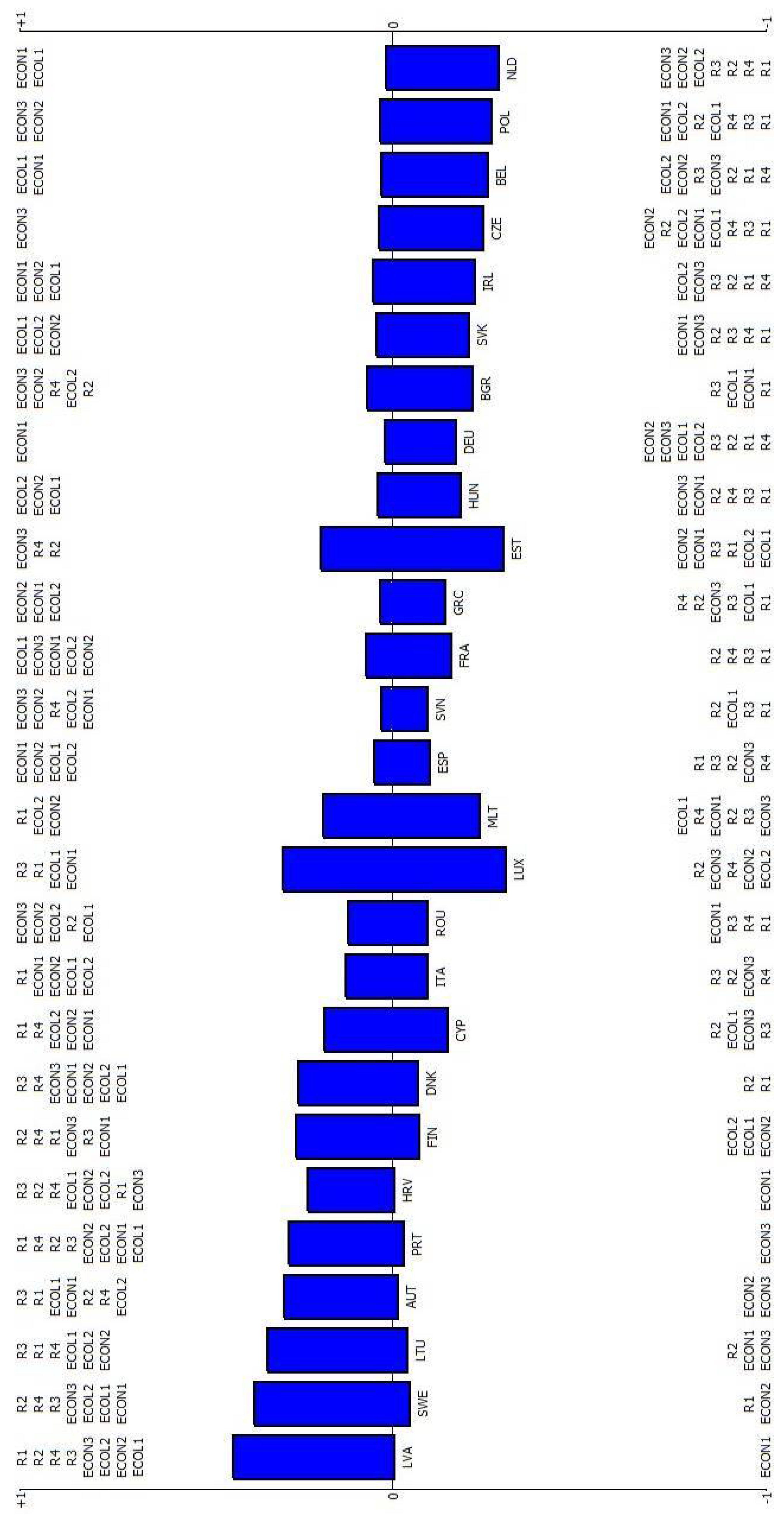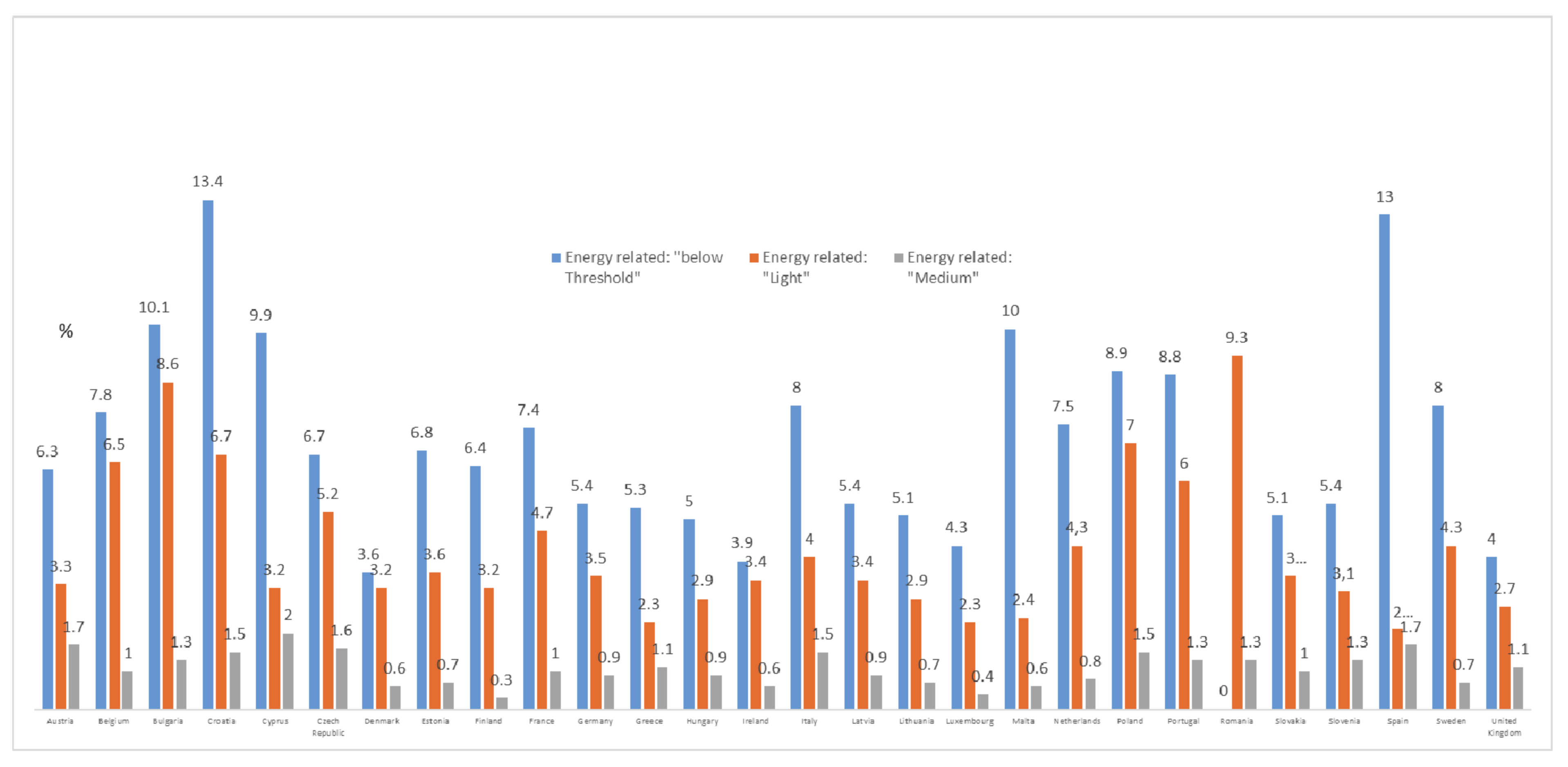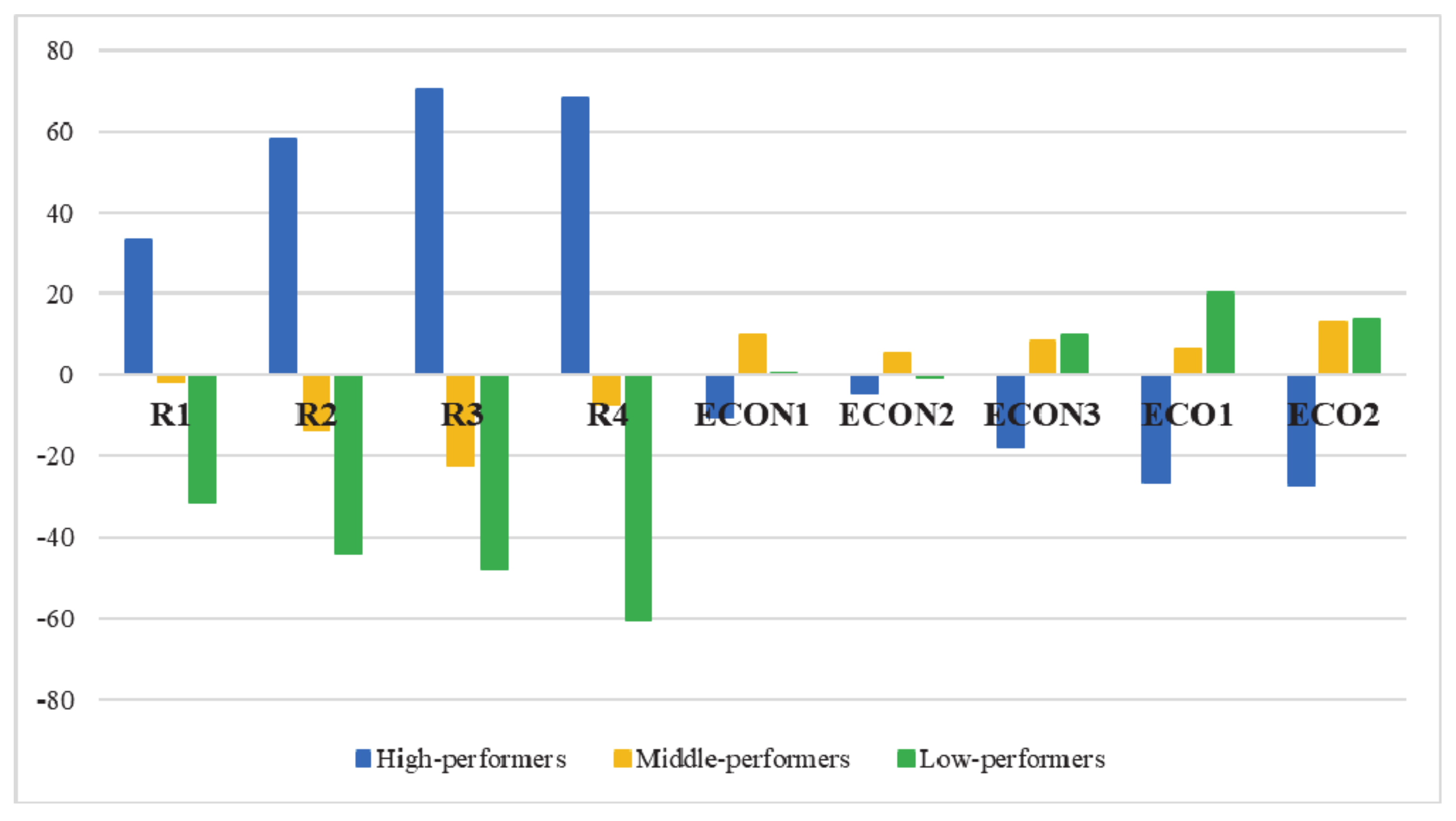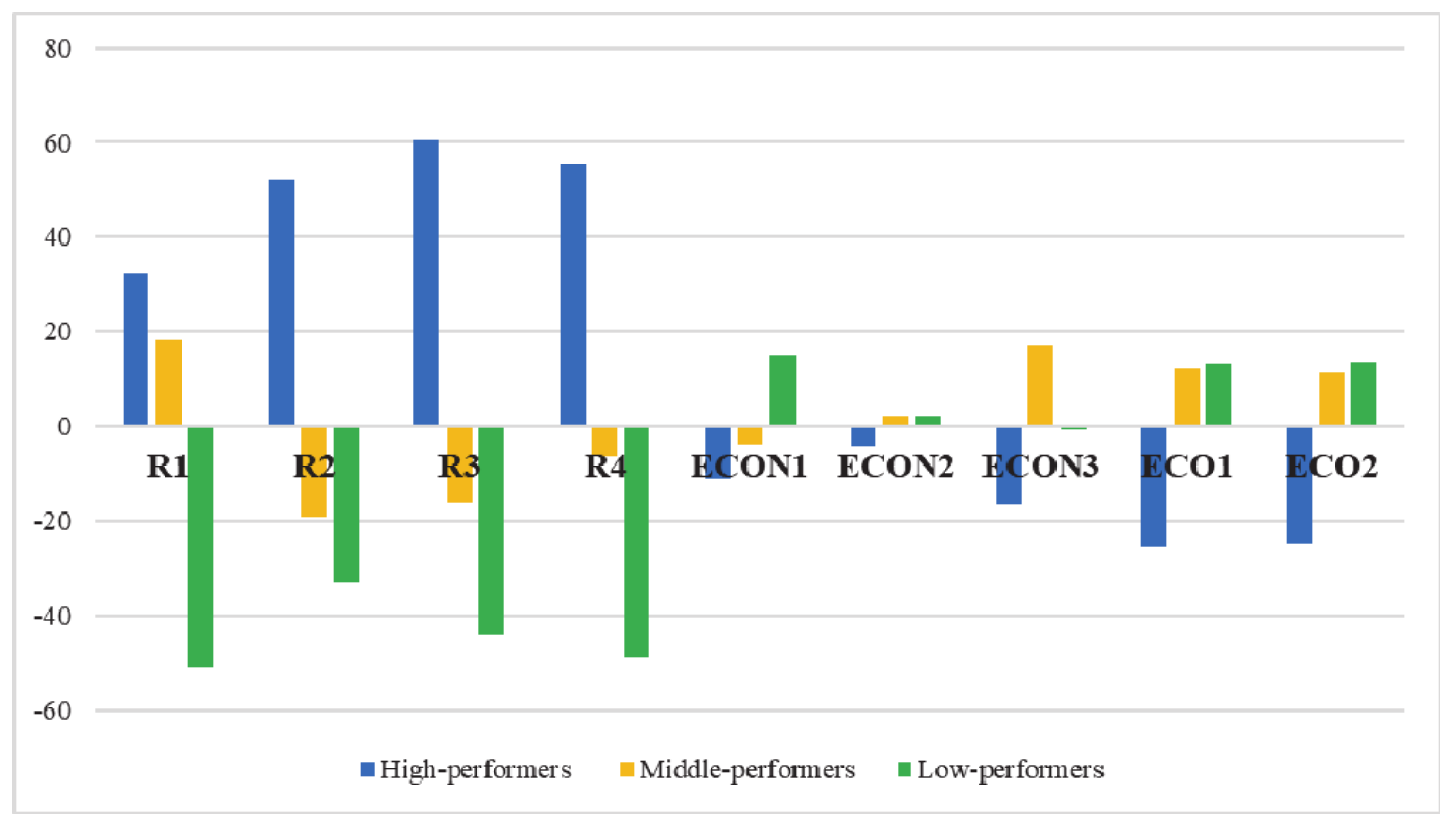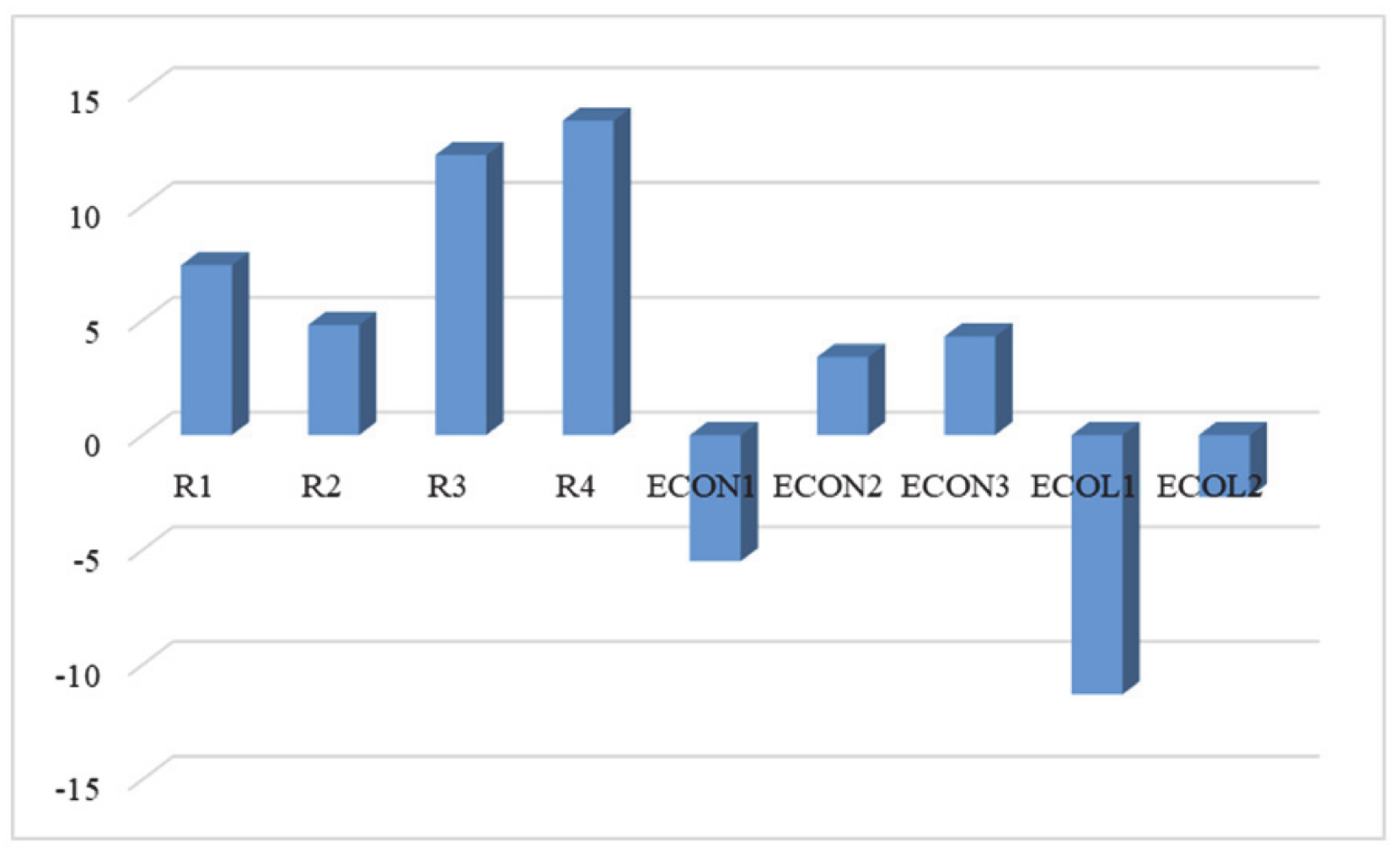1. Introduction
The term “energy efficiency” in its broad sense is associated with the rational use of energy resources [
1]. Recently, however, the meaning and significance of this term have expanded considerably—in addition to the purely economic aspect of the use of energy (i.e., the aspect of resource-saving), the term “energy efficiency” has started covering the issues of inefficient and sometimes even irrational energy consumption detrimental to both consumers and the environment. In this context, the main goal of setting energy efficiency priorities is to find ways to reduce energy consumption without harming consumers and the environment.
To achieve the EU’s long-term energy and climate goals, the European Commission [
2] adopted the EU sustainable development strategy, aimed at tapping the ecological and social potential of the economy and developing the actions that are necessary to be undertaken so that a continuous long-term improvement of the EU population’s quality of life would be achieved through the efficient use of resources. The general objectives set in the strategy were predominantly environmental (climate change prevention, use of clean energy, sustainable consumption and production, and sustainable use of natural resources) [
2]. Based on the aims established in the strategy, the relevant legislative landscape was formed. The climate and energy targets for 2020 were set in the Climate and Energy Package—a set of laws passed in 2020 that required the cut in greenhouse gas emissions by 20% (in comparison to the levels of 1990) to raise production of energy from renewable resources by 20%, and improve energy efficiency by 20% by 2020 [
3]. Within the 2030 Climate and Energy Framework, which sets the EU-wide targets and policy objectives for the period 2021–2030, greenhouse gas emissions must be reduced by at least 40% (compared to the levels of 1990), the minimum share of renewable energy must amount to 32% of the total energy use of the EU, and energy efficiency must improve by at least 32.5% [
4].
The renovation of buildings can be considered one of the main aspects of energy efficiency in the EU. According to the statistics provided by the European Commission, energy consumption of buildings accounts for around 40% of the total energy consumption, and exploitation of buildings generates more than one-third of CO
2 emissions within the EU [
5]. This is the largest energy end-use sector. The statistical data provided within the ODYSSEE-MURE project on energy efficiency and policy monitoring [
6] indicate that “final energy consumption of buildings has increased by around 1%/year since 1990 and by 2.4%/year for electricity at EU level” (p. iv), and annual unit consumption per m
2 amounted to around 220 kWh/m
2 in 2009. Based on the statistics above, the renovation of buildings is one of the tools for achieving the EU’s long-term energy and climate goals. Since the largest part of the EU’s current building stock was built prior to the energy performance standards, the renovation of buildings offers a high potential for energy saving [
7].
Building renovation policy in the EU is based on the Directives on the energy performance of buildings (EPBD) and energy efficiency (EED). Also, research and innovation projects are implemented through the intelligent energy Europe (IEE), 7th framework programme (FP7), European structural and investment funds (ESIF), and the more recent Horizon 2020 program, which continues the support that has already been given through the IEE and FP7. The above-mentioned measures create the preconditions for integrally renovating buildings, following the principles of balancing and urban planning, and allow adopting the most relevant cross-sector solutions to achieve a synergy effect. Nevertheless, the estimations of the European Commission [
7] propose that neither the rate nor the depth of the current energy renovation (0.4–1.2% depending on a member state) lives up to the energy savings potential in terms of renovating buildings. Despite the EU-wide systemic measures, there are still many problems with building renovation in practice. According to [
8], thus far, only 5% of the renovation projects have been able to yield energy-saving at the deep renovation level. Although renovation solutions are available, renovation processes are expensive and prolonged, and a variety of technical complexities hinders the achievement of energy-saving goals within the EU. Thus, although the renovation of buildings has a great potential for energy saving, much of this potential remains untapped. For this reason, it is relevant to research how advanced the EU member states are in exploiting their energy-saving potential through the renovation of buildings.
Previous literature contains a number of the studies that identify the drivers and barriers to the energy-efficient renovation of buildings in the EU [
5,
9,
10,
11,
12,
13,
14], but to the best of our knowledge, no other study has thus far ranked the EU member states according to achieved results in terms of increased usage in renewable sources, a decrease in energy usage and import, and reduction in harmful gas emissions due to energy usage. Hence, the main purpose of this article is to perform a comparative analysis and evaluate the sustainable energy development progress in the EU member states in the context of building renovation. The defined purpose was detailed into the following objectives: (1) to review the findings of previous studies on the major drivers and barriers to the energy-efficient renovation of buildings in the EU; (2) to present and substantiate the research methodology; (3) to rank the EU member states on the mentioned indicators. The methods of the research include comparative literature analysis, PROMETHEE II, and entropy method.
2. The Major Drivers and Barriers to the Energy-Efficient Renovation of Buildings in the EU: Literature Review
Several studies [
8,
15,
16] indicate that energy-efficient renovation of buildings is not on par with its potential, and, according to the Buildings Performance Institute Europe’s (BPIE’s) [
11] data, due to the insufficient monitoring, it is even difficult to estimate whether the target of a 3% annual rate is being achieved.
To intensify the pace and scope of the energy-efficient renovation of buildings, as recently proposed in the Climate and Energy Strategy for 2050 developed by the European Commission [
17], in particular, it is relevant to identify what factors are driving this process and what barriers impede its running. As it was noted by Beillan et al. [
9], many problems arise because buildings, either public or private, possess different characteristics, market stakeholders are of extremely diffuse character, the process of renovation contains unique technical specificities, both house owners and contractors lack the information about the innovative methods of work and potential efficiency gains, funding instruments are insufficient and/or hardly available, etc.
The major drivers and barriers to the energy-efficient renovation of buildings in the EU systematized based on literature analysis are provided in
Table 1.
The information in
Table 1 shows that the drivers to the energy-efficient renovation of buildings in the EU can be categorized as economic, financial, political, information and communication-related, socio-cultural, and environmental.
The category of the economic drivers covers boosting the real estate value and residents’ profit (lower bills). By employing on-site surveys (qualitative interviews), Beillan et al. [
9] analyzed the weight of particular socio-economic factors (willingness and skills of stakeholders, regulation and incentives, norms and values) in the house renovation decision-making process in five European countries (Germany, Switzerland, Italy, Spain, and France) and found that the main drivers to the renovation of residential buildings are the prospects to raise the real estate (housing) value and renovation-associated benefits (lower bills and greater comfort for dwellers). The study revealed that boosting the real estate value through retrofitting is a more influential driver for renovating apartment blocks than detached houses, while the benefits of cost-saving and greater comfort are more important to owners of detached houses.
The significance of economic drivers (which can be collectively referred to as increased profit for a stakeholder) is highlighted in many previous studies on the issue under consideration, and most of them disclose the large potential of savings [
7,
18,
19].
In the category of the financial drivers, the amount and nature of the financial support available are recognized as the key factors significantly affecting an owners’ decision to start renovation projects, especially collective ones [
9]. In this context, the major role is played by the relevant and timely provision of such financial instruments as subsidies, grants for research, innovation and demonstration projects, and tax incentives [
10].
In the category of the political drivers, improvement of the process and regulatory framework, i.e., establishment of mandatory building codes, energy performance standards, and energy efficiency obligation schemes [
10], can be distinguished as the most influential. Bjorneboe et al. [
21] also suggest the provision of the long-term regulation on the maximum energy consumption allowed per house.
In the category of the information and communication-related drivers, the significance of the availability of the relevant information is emphasized in particular. The information for both property owners and contractors can be provided by local advisory bodies, professional consultants, or project managers; by ensuring that the information is disseminated through the media, the stakeholders can find it attractive to analyze the information themselves [
9]. Artola et al. [
9] also propose invoking awareness-raising and information campaigns, issuing EU energy performance certificates, and pursuing energy labeling schemes.
In the category of the socio-cultural drivers, the prospects to boost the real estate value and cost-saving were found to be closely linked to the population’s social and cultural values in terms of socio-economic well-being [
7] manifesting itself, for instance, through greater comfort or enhancing one’s image when living in a renovated house. The survey conducted by the European Commission [
7] revealed that motivation to perform energy renovations might depend on consumers’ age (younger consumers have more confidence in the success of renovation projects) or income (consumers with higher income are more motivated).
Finally, in the category of the environmental drivers, the stakeholders can be driven by the idea that they contribute to protection from global warming and help to raise the proportion of renewable energy used [
7].
Regarding the barriers to the energy-efficient renovation of buildings in the EU, the literature analysis helped to categorize them as economic, financial, political, information and communication-related, technical and industrial, administrative and regulatory, and supply-side.
In the category of economic barriers, researchers primarily emphasize the negative role of high expenses and the opaqueness of costs. According to Artola et al. [
9], the costs that become a burden for property owners and landlords include assessment costs, installation costs, financing costs, costs of understanding regulations, and hidden costs. For authorities, these costs refer to information, set-up, administrating, and monitoring costs. The costs being high, not all stakeholders can afford them, even if a part of the costs is covered by the EU funds [
7].
In the category of the financial barriers, property owners are discouraged by insufficient financial support available or are reluctant to borrow funds for renovations because they are afraid to incur large debt obligations, especially when the share of national funding under the relevant programs is cut, which means higher personal indebtedness in the long run and is particularly unattractive to low- and even middle-income homeowners [
12]. The long payback period from investments in renovation is another discouraging factor [
16]. The survey conducted by the EU Commission [
7] also revealed that one of the barriers is tenants’ distrust of landlords in terms of equal distribution of financial benefits, i.e., tenants are often concerned that the bulk of the benefits will be reaped by landlords. Thus, current investment in the renovation of buildings remains at the suboptimal level [
16].
In the category of political barriers, the key barrier is a lack of incentives and changing policies. Stakeholders often complain about confusing political signals concerning building renovation: funding from national budgets can be reduced when national governments are trying to deal with occurring economic and financial crises by suspending or eliminating energy-efficiency programs [
9], the regulations of the renovation process, as well as ambitions of performance requirements, maybe changing unreasonably quickly for both stakeholders and contractors to keep pace [
10], or a country may lack regulatory constraints and incentives in the area under consideration. Artola et al. [
9] and Economidou [
24] also note that renovation cannot reach the desired scale because there is no single unified definition of energy renovation, but simply it is widely acknowledged that renovation must lead to energy savings after the intervention works. Thus, renovation can encompass a variety of interventions in a building, starting from modernization and ending with routine upgrades [
25], which impedes both submissions of the applications for funding and contracting.
Insufficient communication about the advantages of the deep renovation as well as insufficient technical capacity/knowledge to promote, plan, and implement deep renovations are the key obstacles reported in the category of information and communication [
10]. Sesana and Salvalai [
13] also argue that a lack of transparency, caused by a deficiency of information, undermines investors’ confidence, while Streimikiene and Balezentis [
19] link insufficiency of information to the inability to make collective decisions on renovation, especially in multi-flat buildings.
The socio-cultural barriers are related to social norms, i.e., public perception of the standards of thermal, acoustic, and light comfort, diverging customers’ priorities (e.g., floor space, a building’s aesthetic value), and the preconceived attitudes towards (in)efficiency (e.g., molding, inflammable insulation) [
7]. As it was noted by D’Oca et al. [
12], diverging attitudes and pre-conceptions hinder unanimity on renovation intervention (especially in multi-flat buildings with many owners).
In the category of technical and industrial barriers, the literature helped to identify such a primary obstacle as a lack of innovative technical solutions [
10]. In many cases, architecture, location, and other specific characteristics of a building complicate renovation projects because there are no effective, innovative solutions for how to insulate a building, how to renovate its ventilation systems, etc. Even if basic technical solutions are available, they do not always pay off, and even after the renovation, the energy efficiency of a building is lower or shorter-term than planned. D’Oca et al. [
12] emphasize the negative impact of a lack of consistent and standardized or integrated solutions, i.e., building renovation technologies and techniques are not ensured to comply with new and different building standard requirements. The researchers also note that stakeholders can be discouraged by the safety risk, i.e., the risk that a building can be damaged while conducting deep renovation processes (e.g., retrofitting).
In the category of administrative and regulatory barriers, the existing legal framework in each country may hinder deep renovation. Overlaps between laws, complex administrative processes, and a lack of legislation concerning the split incentives between tenants and owners are some of the barriers reported under this category [
11]. The survey conducted by the European Commission [
7] revealed the complicated dealings of house owners with contractors and sub-contractors (mainly caused by a lack of competence from one or both contracting parties).
Finally, insufficiently structured and specialized supply-side issues can become a barrier being unable to provide high-quality services [
9], initiation of a project can be delayed due to the lack of skilled and qualified energy-efficient retrofit professionals [
10,
11,
12], or the works can be disrupted due to fragmentation of the supply chain [
10].
Conducting a thorough literature analysis helped to identify that the strongest drivers to the energy-efficient renovation of buildings in the EU are economic and financial, although consumers also care about their comfort, personal benefits (e.g., prestige), and environmental contribution. Improvement of the process and regulatory framework, as well as the availability of the information, are influential drivers at the institutional level. Insufficiency and unavailability of economic and financial incentives create key barriers to the energy-efficient renovation of buildings prevalent among consumers, while the lack of well-designed national strategies along with changing policies, varying ambitions, and a lack of transparency are notable at the institutional level. On the supply side, energy-efficient renovation of buildings in the EU is not on par with its potential due to the lack of innovative and consistent technical solutions and insufficiently structured and specialized supply.
According to the statistics of the 2014–2020 cohesion policy funds for energy efficiency in buildings, the budget for buildings (total sum of residential and public buildings) was absorbed as follows (top-10 fund absorbers): the Czech Republic (EUR 991.407,171), Germany (EUR 892.832,893), Greece (EUR 555.777,677), Portugal (EUR 586.542,944), Slovakia (EUR 586.275,034), Lithuania (EUR 496.564,799), Ireland (EUR 84.500,000), Malta (EUR 9.955,116), and Austria (EUR 5.893,940).
Figure 1 depicts energy renovation in residential buildings [
32] by its rate as a percentage.
The statistics above indicate that by the energy renovation rate (“Below Threshold”, “Light”, “Medium”, “Deep”), energy renovation in residential houses in the EU is largely at the “Below Threshold” level. An energy renovation is classified as a renovation “Below Threshold” in cases in which the primary energy demand of a building has been reduced by x < 3% savings compared to the primary energy demand of the building in the calendar year before the energy renovation. Hence, the renovation only insignificantly (by 3%) contributes to energy efficiency. An energy renovation is classified as a light renovation in cases in which the primary energy demand of a building (based on calculated or measured performance) has been reduced by 3% ≤ x ≤ 30% savings compared to the primary energy demand of the building in the calendar year before the energy renovation. The most advanced countries at this level are Romania (9.3%), Bulgaria (8.6%), Belgium (6.5%), Poland (7%), and Croatia (6.7%). An energy renovation is classified as a medium renovation in cases in which the primary energy demand of a building (based on calculated or measured performance) has been reduced by 30% < x ≤ 60% compared to the primary energy demand of the building in the calendar year before the energy renovation. The EU average at this level is only 1.1%. Deep renovation has the potential to reduce the energy consumption of the building stock by 36% until 2030, but, according to the statistics, the average “deep” rate of the EU is only 0.1%.
5. Conclusions
The obtained results may lead to several theoretical and methodological contributions, as well as practical and policy implications. In terms of theory development, our results based on the comparative analysis have revealed how the studied indicators changed in 2018 compared to the results of 2014. The developed theoretical framework provides opportunities to continue studies providing data in three categories of countries based on their performance in relation to energy efficiency caused by the investments in buildings’ renovation. Of importance is to look deeper into the factors determining the level of efficiency in separate EU countries, as well as into drivers and barriers leading the process of the energy-efficient renovation of buildings. Such studies could explain in detail the peculiarities of our results, commenting on the reasons influencing the movement of individual EU countries between low-performers, middle performers, and high performers in terms of energy efficiency.
The methodological contribution of our study is related to developing a complex and robust research method for investment efficiency assessment allowing for the three groups of indicators related to the usage of renewable energy sources, energy efficiency, and ecological aspects of energy. It was based on the PROMETHEE II method and allows testing it in other time periods, as well as modifying it for research purposes.
As practical contributions of the current research, it is worth mentioning managerial implications that may be useful for laying down ground rules for developing and implementing strategies for building renovations on the governmental level of public authorities—among others, developing informational campaigns for the general public, as well as considering policies targeted at eliminating barriers and supporting driving forces for energy-efficient housing renovation. Policymakers should carefully consider the place in the rankings of their country related to the energy efficiency of renovated buildings and take steps towards moving it to a high-performer, or ensuring stability, in case their country is already present in this category.
To fasten the pace and scope of building renovations, it is necessary to develop policy innovation for building renovation. It generally refers to an approach aiming at creating added value and improving the effectiveness and efficacy of an existing policy to achieve the desired outcome, such as engaging the public in policy development, introducing suitable incentives, new evaluation methods, and innovative ways of funding. Various elements of a policy can be regarded as innovative: the renovation rate, a new tax break on renovation works, how the policy is designed, its application procedure, public/private partnership, and how it is being governed (how it is managed, who makes decisions).
Our results based on the proposed research methodology and indicators have several limitations that offer opportunities for future research. The major limitation of the study is data unavailability for some important indicators in this area. This is why some of the indicators regarding building renovation have not been included (the last available data for those indicators are from 2016), and analysis has been based on data for 2018 (some of the included data are not available for 2019).

